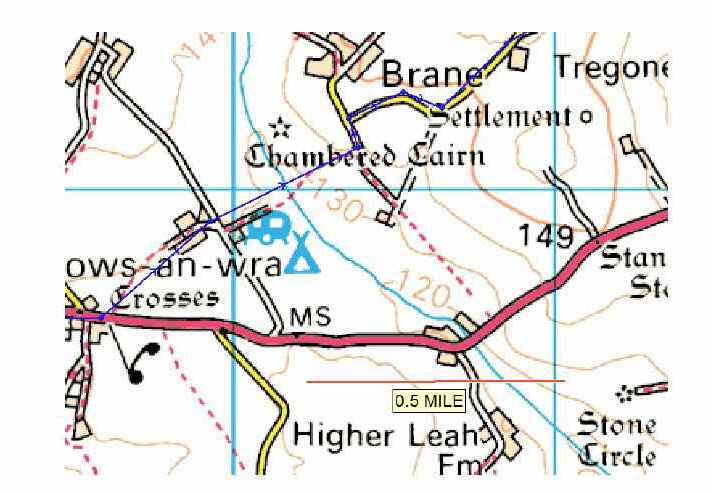 |
|
| Days N1 - N14 English West Country | |
| Northbound
Home Start hiking here English West Country English Midlands North of England Southern Scotland Central Scotland Scottish Highlands Southbound Home |
Friday,
March 23, 2007
Time of departure: 8.45am Time of arrival: 6.00 pm Place departed: Carnon Downs, Cornwall Place arrived: St. Austell, Cornwall Miles: 19.1 Cum miles: 59.1 Percent complete: 6.3  Trenare
Guest
House, St Austell * Trenare
Guest
House, St Austell *Cost for bed and breakfast: £30 ($60) |
| Overview of both
hikes Excerpts Statistics What others say Acknowledgments Contact me Copyright Links |
|
 |
|
| This is a while-hiking image on the PDA, my planned route in blue. The shot is about twice actual-size in each direction. Using the PDA's stylus, the map can be scrolled, and zoomed in or out. This is the most zoomed-in setting. A GPS position can be shown, and with time can generate a trace of the actual route taken, though leaving it on drains the PDA's batteries | |
| There
is no
single route between Land’s End and John o’Groats.
Having said this, there are some preferred routes. Among
these is
a 1150-mile route described by Andrew McCloy, though he also offers
some alternatives. See Andrew McCloy, The Land’s End to John
o’Groats Walk (Cordee, Leicester, England,
2002).
McCloy’s book describes his route section-by-section in
sufficient detail to make it a take-with guide, especially since
it’s compact and light. His route includes the Pennine Way and
the West Highland Way, two of Britain’s most striking walking
trails, and it’s the route taken by Mark Moxon. Moxon describes his experiences on probably the best website of all for the end-to-end or any other hike, www.landsendjohnogroats.info, which has great photos and a discussion forum. The site is not only a guide to the route but an entertaining travelog. Moreover, Mark also extracted material from his website to create an excellent book (When I Walk, I Bounce: Walking from Land’s End to John o’Groats) though it's hard to find a copy. Mark inspired me and helped with lots of advice. But my own route was different, mainly because my knees made me want to avoid a really rigorous routing, which the Pennine way is. Among many other routes is one by Philip and Marilyn Slater, described at www.ukendtoend.com. From this site, you can read and print their ebook: Stepping out of the Railway Tracks. Their route was different from Moxon’s and McCloy’s in being both more direct and more rural, and it makes a great account also. I also want to mention the routes taken by two hiking contemporaries, Alan Sloman and Dave Greenwood. Starting two weeks before me, Alan combined his end-to-end walk with a coast-to-coast one, and in so doing extended the mileage from the customary 900 - 1,200 for the end-to-end walk alone to an impressive 1,660 miles. Alan did his walk for charity – the Sue Ryder organization, at whose hospice his father was cared for. I was not raising money for charity, but – if you feel inclined and his blog is still up – check in with Alan at www.alansloman.blogspot.com. Then, too, Dave Greenwood writes nicely of his very fast and recent, end-to-end hike, in winter no less: www.imsodave.blogspot.com. There are other end-to-end accounts, many described on the web, but those I mention influenced my planning the most. In the end, I chose my own path, and finalized it as I proceeded. My planned route was approximately 950 miles. Today’s hike started effortfully but ended effortlessly. Perhaps it was Mark Moxon’s decision to lessen his pack weight enroute that helped with this. Following Mark’s lead, I took 3 lb from my pack last night – 2 lb of which I would put in the mail next day to lighten my pack, and 1 lb that I jettisoned at the guest house. I mailed the package at the post office in the cathedral city and county seat of Truro at about lunchtime, and immediately hit my stride. I then decided not to stop in Grampound after twelve miles or so, which committed me to about 19 miles because the next accommodation was in St. Austell. There, the shadows were lengthening as I arrived in town. My theory about pack weight is perhaps what you’d expect from the engineer that I am. My feeling is that the first 10 lb of pack weight (approximately, that is, and differing according to a person’s strength and build) is basically not noticeable. Weight beyond 10 lb is therefore felt in proportion to the amount above 10 lb and not the total weight. In this way a 30-lb pack feels twice as heavy as a 20-lb one. My weight reduction of 3 lb was therefore more appreciable (and appreciated) than it may seem. For the most part, today was a highway-day, interspersed with minor-road alternatives for perhaps one-fourth of the distance. The highways (A390 for the most part) often had a just-adequate shoulder of about 18 in, forcing one on to the grass verge when traffic seemed threatening. The other, more minor roads that I sometimes employed were almost devoid of traffic, and the old road from Carnon Downs to the outskirts of Truro was especially peaceful and scenic. As with yesterday and the day before, many roads were uphill and downhill. As I dragged myself up a hill on a country lane beyond Truro, I found myself alongside a man carrying his groceries. We talked, and soon enough I invited him in a teasing way to do a marathon walk also. But, as if provoked to reject this idea as soon as possible, he strode away ahead of me, saying it was all he could do to carry his groceries up the hill. I didn't tell him that climbing that hill was all that I could manage myself. As he strode ahead of me, he let on that he was 91-years old, which quite shamed me. The vistas were mostly delightful today, with pastoral scenes to distant horizons. As I arrived in St. Austell, I booked accommodation by phone, only to then pass half a dozen other places with vacancies. All of them might well have been better than the indifferent place that I had booked. This taught me a lesson. At this slow tourist time of the year, before Easter, it might be better to wait and look, even if booked accommodation makes for a more secure feeling. One of the reasons I call the Trenare Guest House "indifferent" was the shower. This may be a good time to explain British B&B plumbing to non-Brits, which is a bit like explaining a roundabout (traffic circle) to Americans: they both make sense once you understand. Retrofitting old homes with as many bathrooms as can be squeezed in is, well, a challenge. One of the challenges is drains, of which more in a minute. On the water supply side, it can waste a lot of energy and water to run hot water from a central hot weater heater to all the rooms. Instead, flash-heating is very often used, which is facilitated by the 220 volts standard supply in Britain (in the U.S. and Canada, the supply standard is only 110 volts). With this higher voltage already present through the home, water can be heated "on demand" right at the shower. The caveat is that the water volume can't be too high, and that's supplemented by another constraint in that the landlady doesn't want you to use too much electricity or water either. So these showers often run pretty low volumes, at low temperatures, and are programmed with timers behind the scenes which shut them off quickly. How quickly? Well, at about the moment that the temperature feels right, and you've lathered up, you can guess what may happen. Now the supply is one thing, but drainage is quite another. When the installation doesn't allow a place for drain pipes under the floor, the shower, and for that matter the toilet, are often built on plinths that raise them six to nine inches above floor level. The drain pipes are then fitted in the plinth, which is a wood structure hiding the drain, and another boxed structure may also be present along the walls to hide the pipes running along the perimeter of the room to reach a distant, main drain. Such dedication to drainage takes a further heroic step in cases where there is no main drain line close enough to run the drain lines by gravity even after raising the shower and toilet on to a plinth. That's when an electric pump is installed to pump the drains away. In the case of a toilet, this means a macerator, which liquidizes the toilet's contents before pumping it away, as on a boat. So, at its worst, you can lie in bed asleep when the drain pump and macerator come on and make juddering noises to empty the drain lines that may run next to your bed, before switching off for just long enough for you to get to sleep again. At about that moment, due to a dripping tap or a leaking toilet valve, the pump and macerator can come on again to wake you up. I hasten to say that the Trenare Guest House did not exhibit all these characteristics, but here I started to get an education into this wonderful world (British B&B Plumbing 101), before going on to 201 in other establishments. I'd been happy with the condition of my feet, but an ache at the end of one toe now translated into a bruised nail, which I feared would trouble me tomorrow. I thought my boots must be too small, or my feet were swelling, which amounts to the same thing. The worrying thing about my left knee was that I needed anti-inflammatories to relieve the pain, which was not something I wanted to resort to so soon into the hike. However, perhaps my reduced pack weight would help with this. I awaited tomorrow with curiosity after such a long hike today. Having walked for four days now, my left knee pain played right into the worst fears from my Tampa training experience. Indeed, my mood paralleled the feelings in my left knee, and I was also starting to feel isolated from family and friends. |
|
 |
|
| Credit-card sized eating utensils. They can also open a bottle and a can. The nearest thing I've seen to this recently is a set of even-more-versatile multitools, shown at www.knivesinfinity.com; see, for example, the credit card companion there, weighing 1.3 oz. It has a serrated blade, a can/bottle opener, a flat screwdriver, an awl, a compass, an 8x power lens, a tweezer, a toothpick, inch/cm rulers and a lanyard hole | |
| Day N3 © 2007 and 2008 Daryl May Day N5 | |